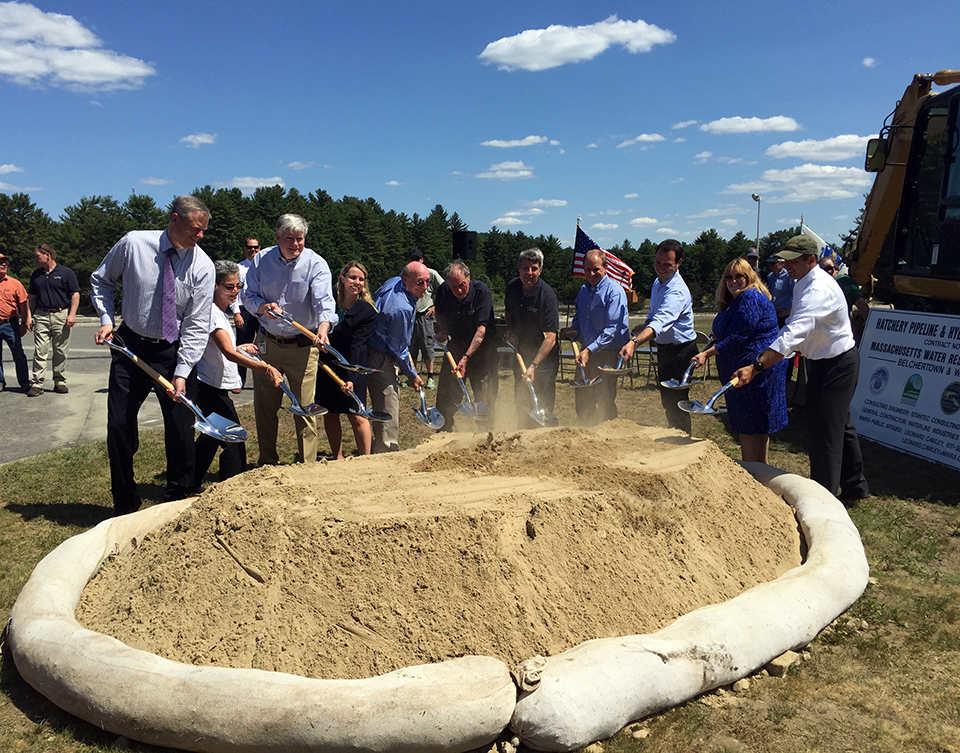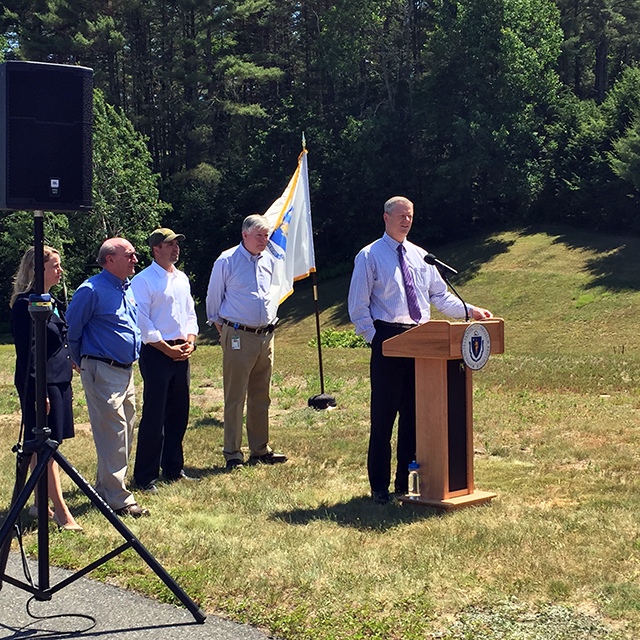BELCHERTOWN – June 24, 2016 – Governor Charlie Baker and Energy and Environmental Affairs (EEA) Secretary Matthew Beaton today joined anglers and state and local officials at the McLaughlin Fish Hatchery in Belchertown for a groundbreaking ceremony to celebrate the construction of a nearly mile-long water pipeline and hydropower turbine that will supply six million gallons of water daily to the hatchery, produce renewable energy and reduce the hatchery’s electric demand.
“This project will supply the necessary cold water needed by the Commonwealth’s largest trout hatchery for decades to come, while lowering operational costs, saving energy and producing a renewable source of power,” said Governor Charlie Baker. “This allows for increased energy security and further reduction of greenhouse gas emissions.”
“This great multi-agency partnership will improve trout hatchery operations while also helping the state meet its clean energy targets,” said Lieutenant Governor Karyn Polito. “By developing renewable resources and reducing energy use, the Commonwealth is working towards a clean, affordable and resilient energy future.”
“Once complete, this pipeline will save money by harnessing hydropower to reduce electric demand and produce clean energy, and will also help the state provide a quality trout fishing experience for local and visiting anglers to Massachusetts,” said EEA Secretary Matthew Beaton. “Innovative projects like this one are the reason the Commonwealth continues to lead the way on clean energy, energy efficiency and the adoption of new technologies.”
The new 20-inch diameter pipeline, a nearly mile-long spur from the Massachusetts Water Resources’ (MWRA) Chicopee Valley Aqueduct, will deliver water from the Quabbin Reservoir to the McLaughlin Fish Hatchery. The pipeline will begin near the MWRA’s Brutsch Water Treatment Facility in Ware, cross Route 9 into Belchertown and parallel East Street down to the hatchery.
“We are delighted to be working with the Division of Fisheries and Wildlife and the Department of Energy Resources on this important project,” said MWRA Executive Director Fred Laskey. “It’s a great opportunity to help the hatchery and provide a new source of renewable energy within our water system.”
Currently, the McLaughlin Fish Hatchery pumps water directly to its water distribution system from the Swift River. However, because trout prefer cold water, warm river temperatures during the hot summer months affects trout production. The new pipeline will deliver water from the cold, deep bottom of the Quabbin Reservoir, providing consistently coldwater temperatures that will enhance the hatchery’s capacity to raise trout.
“The McLaughlin Hatchery, our largest of five hatcheries, produces almost half of the agency’s hatchery trout, about 225,000 pounds of brook, brown and rainbow trout,” said Department of Fish and Game Commissioner George Peterson. “The fish are then stocked in nearly 500 rivers, streams, lakes and ponds throughout Massachusetts.”
“MassWildlife’s trout stocking program has always been very popular with anglers,” said MassWildlife Director Jack Buckley. “Our new trout stocking webpage with daily schedule updates is one of the 10 most visited websites in the entire Commonwealth system.”
Gravity-fed water from the pipeline eliminates the need for energy to pump water from the river, reducing the hatchery’s electrical demand by 588,000 kilowatt hours annually. As the water travels from the higher-elevation reservoir down to the hatchery, it will pass through an approximately 60 kilowatt hydropower system, producing an estimated 440,000 kilowatt hours of renewable energy annually that will be exported to the power grid.
“Massachusetts is a national leader in clean energy and energy efficiency and our state agencies are leading the way with innovative projects like the McLaughlin Hatchery Pipeline,” said Department of Energy Resources Commissioner Judith Judson. “DOER is committed to working with our partners across the Commonwealth to expand clean and renewable energy solutions that save taxpayer dollars.”
“This is a great example of one project serving many purposes and providing multiple benefits,” said State Representative Susannah Whipps Lee (R-Athol). “This innovative project will benefit the residents of the Quabbin region for years to come.”
“This is a terrific example of state agencies working together in innovative ways,” said State Representative Todd Smola (R-Warren). “It seems fitting that cold water from the Quabbin will be used to raise trout that will go to stock the reservoir later on.”
“I thank the Baker Administration for recognizing the importance of our natural resources and helping to sustain our trout hatchery,” said State Senator Anne Gobi (D-Spencer). “Keeping a viable hatchery in an environmentally sound way is a win-win for all of us.”
“We support this pipeline project 100%,” said Bill Rose, President of the Western Massachusetts Fly Fishermen. “It’s good for the trout and it looks like a great solution to the problem of varying water temperatures and the constant need to clear river debris from pump station intake screens.”
Funding for the $4.4 million project includes $2.2 million in state environmental bond funds, approximately $1 million from MWRA bonds, $700,000 from the Massachusetts Clean Energy Center and the Department of Energy Resources’ Leading by Example Program, and $500,000 from the Division of Fisheries and Wildlife’s (MassWildlife) Inland Fish and Game Fund. MWRA awarded a contract to Waterline Industries Corporation to build the pipeline and the hydropower project.
Massachusetts Water Resources Authority
Commonwealth of Massachusetts
Executive Office of Environmental Affairs Press Release
Date:
June 24, 2016
Contacts:
Katie Gronendyke
Executive Office of Energy and Environmental Affairs
617-626-1129, katie.gronendyke@state.ma.us
Ria Convery
Massachusetts Water Resources Authority
(617) 788-1105, ria.convery@mwra.com

Executive Office of Environmental Affairs
Governor Charles D. Baker
Lt. Governor Karyn E. Polito
Secretary Matthew A. Beaton

###
Follow EEA Secretary Beaton on Twitter:................www.twitter.com/masseea
View downloadable photographs on Flickr: ...........www.flickr.com/photos/masseea/sets/
Visit the Energy Smarts blog:..................................www.mass.gov/blog/energy
Visit The Great Outdoors blog:............................... www.mass.gov/blog/environment
Visit our website:.....................................................www.mass.gov/eea
100 Cambridge Street, Suite 900, Boston, MA 02114-2119 — (617) 626-1000 office / (617) 626 1181 (fax)
Follow us |
Updated
September 30, 2016

